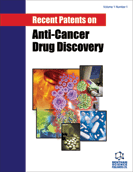
Abstract
Epigenetic modifications have been causally linked to cancer development and progression, and are potentially reversible by drug treatments. The N-terminal tails of histones contain amino acid residues modifiable by posttranslational modifications such as acetylation. Given that HDAC inhibitors induce cancer cell differentiation and death, an increasing number of these compounds has been synthesized in the last ten years. Many HDAC inhibitors are in clinical trials for the treatment of cancer. Two of them, the hydroxamic acid (SAHA) and Romidepsin (FK 228), are approved in the second line treatment of refractory, persistent or relapsed Cutaneous T Cell Lymphoma (CTCL). The growing evidence of the potential benefits of an anti-cancer treatment based on the use of HDAC inhibitors have led to a large number of patent applications all over the world. The aim of this review is to give an overview of the basic current knowledge and molecular mechanisms of HDAC inhibitors and their clinical trials as well as to focus on the recent patent applications existing in the field of HDAC inhibitors and cancer treatment between 2008 and 2010 in USA.
Keywords: Cancer, epigenetics, human diseases, HDAC inhibitors, neurodegeneration, signal transduction, SAHA, CTCL, TFIIE, GATA-1, Vorinostat, Panobinostat, Belinostat, Givinostat, Romidepsin, Entinostat, Tacedinaline, Aquifex aerolicus, fludarabine, thrombocytopenia, YM753, Valproic Acid, SIRT
Recent Patents on Anti-Cancer Drug Discovery
Title: Histone Deacetylase Inhibitors: Recent Insights from Basic to Clinical Knowledge & Patenting of Anti-Cancer Actions
Volume: 6 Issue: 1
Author(s): Vincenzo Carafa, Angela Nebbioso and Lucia Altucci
Affiliation:
Keywords: Cancer, epigenetics, human diseases, HDAC inhibitors, neurodegeneration, signal transduction, SAHA, CTCL, TFIIE, GATA-1, Vorinostat, Panobinostat, Belinostat, Givinostat, Romidepsin, Entinostat, Tacedinaline, Aquifex aerolicus, fludarabine, thrombocytopenia, YM753, Valproic Acid, SIRT
Abstract: Epigenetic modifications have been causally linked to cancer development and progression, and are potentially reversible by drug treatments. The N-terminal tails of histones contain amino acid residues modifiable by posttranslational modifications such as acetylation. Given that HDAC inhibitors induce cancer cell differentiation and death, an increasing number of these compounds has been synthesized in the last ten years. Many HDAC inhibitors are in clinical trials for the treatment of cancer. Two of them, the hydroxamic acid (SAHA) and Romidepsin (FK 228), are approved in the second line treatment of refractory, persistent or relapsed Cutaneous T Cell Lymphoma (CTCL). The growing evidence of the potential benefits of an anti-cancer treatment based on the use of HDAC inhibitors have led to a large number of patent applications all over the world. The aim of this review is to give an overview of the basic current knowledge and molecular mechanisms of HDAC inhibitors and their clinical trials as well as to focus on the recent patent applications existing in the field of HDAC inhibitors and cancer treatment between 2008 and 2010 in USA.
Export Options
About this article
Cite this article as:
Carafa Vincenzo, Nebbioso Angela and Altucci Lucia, Histone Deacetylase Inhibitors: Recent Insights from Basic to Clinical Knowledge & Patenting of Anti-Cancer Actions, Recent Patents on Anti-Cancer Drug Discovery 2011; 6 (1) . https://dx.doi.org/10.2174/157489211793980088
| DOI https://dx.doi.org/10.2174/157489211793980088 |
Print ISSN 1574-8928 |
| Publisher Name Bentham Science Publisher |
Online ISSN 2212-3970 |
 27
27
- Author Guidelines
- Graphical Abstracts
- Fabricating and Stating False Information
- Research Misconduct
- Post Publication Discussions and Corrections
- Publishing Ethics and Rectitude
- Increase Visibility of Your Article
- Archiving Policies
- Peer Review Workflow
- Order Your Article Before Print
- Promote Your Article
- Manuscript Transfer Facility
- Editorial Policies
- Allegations from Whistleblowers
Related Articles
-
Toward The Rational Design of Cell Fate Modifiers Notch Signaling as a Target for Novel Biopharmaceuticals
Current Pharmaceutical Biotechnology Mammalian Target of Rapamycin as a Therapeutic Target in Leukemia
Current Molecular Medicine NGR-based Strategies for Targeting Delivery of Chemotherapeutics to Tumor Vasculature
Anti-Cancer Agents in Medicinal Chemistry The Pro-Survival Function of Akt Kinase can be Overridden or Altered to Contribute to Induction of Apoptosis
Current Cancer Drug Targets An Updated Review of Natural Products Intended to Prevent or Treat Oral Mucositis in Patients Undergoing Radio-Chemotherapy
Current Pharmaceutical Biotechnology Bruton's Tyrosine Kinase Inhibition in the Treatment of Preclinical Models and Multiple Sclerosis
Current Pharmaceutical Design Production and Application of Copper Radiopharmaceuticals
Current Radiopharmaceuticals Development of a STAT5 Phosphorylation Assay as a Rapid Bioassay to Assess Interleukin-7 Potency
Current Pharmaceutical Biotechnology STAT-1 and STAT-3: Closely Related Transcription Factors with Antagonistic Effects on Cell Proliferation and Apoptosis
Current Genomics How Much of the Proteome Do We See with Discovery-Based Proteomics Methods and How Much Do We Need to See?
Current Proteomics E2F1 Reduces Sorafenib’s Sensitivity of Esophageal Carcinoma Cells via Modulating the miR-29c-3p/COL11A1 Signaling Axis
Current Molecular Pharmacology OSI-027 Alleviates Oxaliplatin Chemoresistance in Gastric Cancer Cells by Suppressing P-gp Induction
Current Molecular Medicine The Epidermal Growth Factor Receptor as a Therapeutic Target in Glioblastoma Multiforme and other Malignant Neoplasms
Anti-Cancer Agents in Medicinal Chemistry Gene Delivery for Cancer Therapy
Current Drug Delivery Protein Phosphorylation Mechanism of Mesenchymal Stem Cells in the Treatment of Sepsis: A Systematic Review and Meta-analysis
Current Molecular Medicine Prospectives for Gene Therapy of Retinal Degenerations
Current Genomics Somatostatin and Octreotide on the Treatment of Acute Pancreatitis - Basic and Clinical Studies for Three Decades
Current Pharmaceutical Design Understanding the Use of Immunosuppressive Agents in the Clinical Management of IBD
Current Drug Targets Updates on the Role of FDG-PET/CT in Gynecological Malignancies
Current Molecular Imaging (Discontinued) Protein-Protein Interaction Inhibitors: Small Molecules from Screening Techniques
Current Topics in Medicinal Chemistry


























